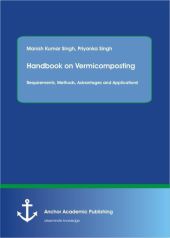 Neuerscheinungen 2014Stand: 2020-02-01 |
Schnellsuche
ISBN/Stichwort/Autor
|
Herderstraße 10
10625 Berlin
Tel.: 030 315 714 16
Fax 030 315 714 14
info@buchspektrum.de |

Handbook on Vermicomposting: Requirements, Methods, Advantages and Applications
Erstauflage. 2014. 148 S. 220 mm
Verlag/Jahr: ANCHOR ACADEMIC PUBLISHING 2014
ISBN: 3-9548927-6-6 (3954892766)
Neue ISBN: 978-3-9548927-6-1 (9783954892761)
Preis und Lieferzeit: Bitte klicken
Now-a-days the use of chemical fertilizers and pesticides in agriculture has reached its peak. This harms the human health as well as environment. The process of agricultural modernization has been an important contributing factor towards this. This deprives the land from its fertility and leaves it unfit for further agricultural operations. Hence, a better alternative of such chemical monsters is required to overcome these ill-effects. Therefore, a shift from chemical to organic farming is appreciated. Production efficiency, economic efficiency and employment generation efficiency of any system is a direct measure of its preferability. Therefore, this study deals with the requirements, methods, advantages, etc. of vermicomposting as well as its applications in agriculture. The main purpose of this process is the quick and efficient conversion of the organic waste materials into the nutritious fertilizer for plants
Text Sample:
Chapter 1: TYPES OF COMPOSTING:
Composting is biological conversion of organic matter into humus-like material called compost by heterotrophic microorganisms such as bacteria, fungi, actinomycetes and protozoa. The process occurs naturally. Right organisms, feed material, moisture, aerobic conditions and nutrients are needed for microbial growth. At optimum conditions, the composting process can occur at a much faster rate.
According To Its Nature:
Aerobic composting: - It stands for composting in the presence of air. Organic waste are broken down quickly and is not prone to smell. It requires high maintenance as it needs to be turned on a regular basis to keep air in the system and temperatures up. It is also likely to require accurate moisture monitoring. This type of compost is good for large volumes of compost.
Anaerobic composting: - It stands for composting in the absence of air. Anaerobic composting requires low maintenance as waste is simply throw in a pile. It is a slow process. It may take years to break down. Anaerobic composting produces awful smell. The bacteria break down the organic materials into harmful compounds like ammonia and methane.
Vermicomposting: - Composting is carried out by red worms including bacteria, fungi, insects and other bugs. The broken organic materials are utilized by the others to eat. Red worms eat the bacteria, fungi and the food waste and then deposit their castings. Oxygen and moisture are required for healthy composting. It requires medium level maintenance. One needs to feed the red worms and monitor the conditions.
According To Its Use:
Industrial systems: - Industrial composting systems are popularising these days as an alternative to landfills. Untreated waste breaks down anaerobically in a landfill, producing methane gas and adds to greenhouse effect. It aims at treating biodegradable waste before it enters a landfill to harm.
Agriculture: - Windrow composting is used in agriculture. It is the production of compost by piling organic matter or biodegradable waste such as animal manure and crop residues, in long rows (windrows). This method is appropriate for producing larger volumes of compost. These rows are generally turned to improve porosity and oxygen content, mix in or remove moisture and redistribute cooler and hotter portions of the pile. Windrow composting is commonly used for farm scale composting.
Home: - Home composting is the simplest way to compost. At home, composting is generally done by using composting bins or in the form of pile composting. Other methods include trench composting and sheet composting. It is a small scale process and requires less outlay of capital and labour.
The World is Catching On
Vermicomposting is being adapted globally, especially in the warmer climates. India and Cuba are among the leaders.
Cuba:
When the Soviet Union fell, it became impossible for them to import commercial fertilizer. Vermicompost has been the largest single replacement for commercial fertilizer by Cuba. In 2004, about 1 million ton of vermicompost was produced on the island.
India:
About 200,000 farmers practice vermicomposting and a network of 10,000 farmers produce 50,000 metric tons of vermicompost every month.
Farmers in Australia and the West Coast of the U.S. are also starting to use vermicompost in greater quantities.
Scientists at several Universities in the U.S., Canada, India, Australia, and South Africa are documenting the benefits of vermicompost, providing facts and figures that support the observations of those who have used it.


